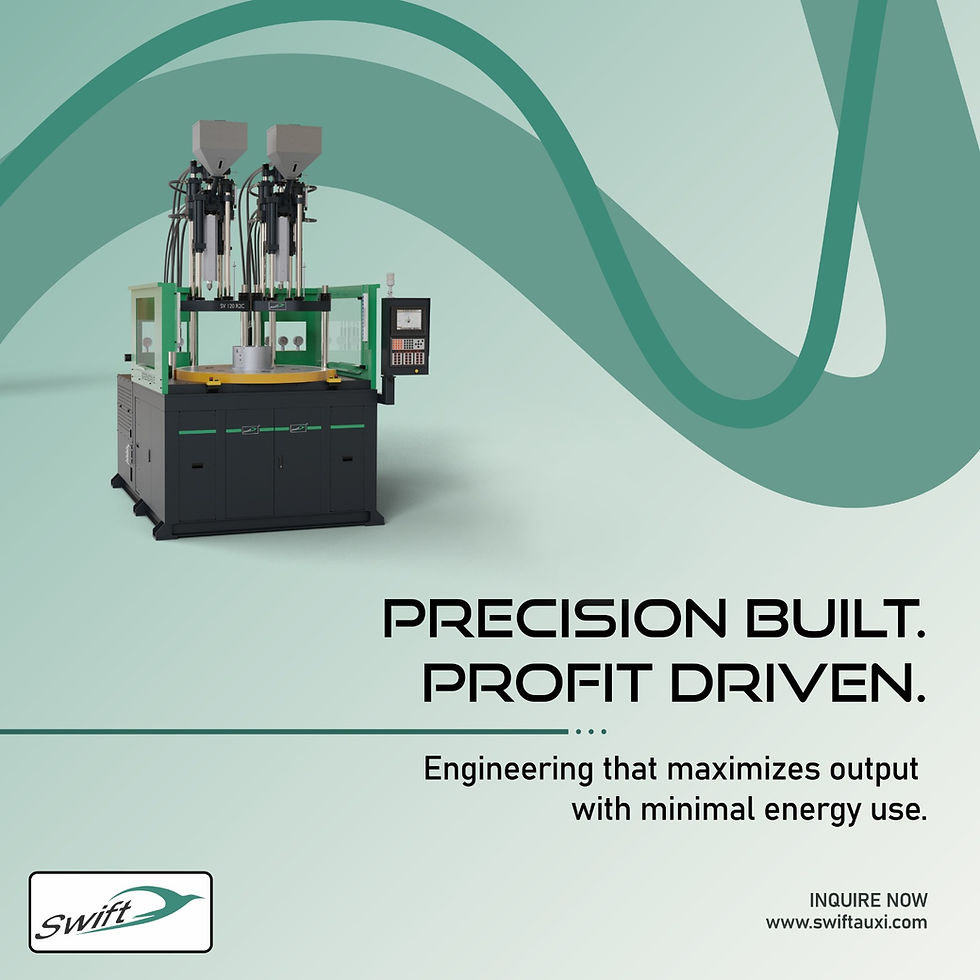Understanding Vertical Injection Moulding Machines: A Comprehensive Guide (1/4)
- Bhoomit Panchal

- Jul 26, 2024
- 3 min read
In today's world, plastic components are indispensable, yet their manufacturing can be challenging. Vertical injection moulding machines simplify and accelerate the production of certain plastic parts, making the process much more efficient. Let's delve into the realm of vertical injection moulding and insert moulding, exploring how these machines operate and why they are essential.

In this blog series, we will address four key topics:
What are vertical injection moulding machines?
Why are they important?
Types of Vertical injection moulding machines
Let's start with what vertical injection moulding machines are.
Vertical injection moulding machines are specialized systems where the entire injection moulding process occurs in the vertical direction. Both the clamping unit and the injection unit operate vertically, offering numerous benefits for insert moulding and the overall injection moulding process.
In conventional injection moulding machines, the clamping unit opens and closes the mould horizontally during the operation cycle, while the injection unit, responsible for melting material and injecting it into the clamped mould cavity, also functions horizontally. This arrangement presents both advantages and disadvantages for the complete process.
In contrast, vertical injection moulding machines feature a vertical layout, with the clamping and injection units stacked on top of each other. This configuration results in a compact physical footprint and provides several advantages over conventional horizontal machines, particularly in insert moulding, overmoulding, two-color moulding, and more.
Vertical injection moulding machines offer significant advantages for insert moulding, over-moulding, two-colour moulding, and two-material moulding. With a vertically functioning clamping unit, the mould opens and closes vertically, ensuring that inserts are placed securely and do not shift within the mould cavity.
The vertical setup of the injection unit also reduces the machine's footprint and enhances injection control, providing high-precision injection due to the natural influence of gravity.
This vertical configuration minimizes physical space requirements, enabling specialized applications that boost production output from a single machine. Features like single-station sliding tables, two-station sliding or rotary tables, and the use of multiple moulds can significantly increase production output compared to standard machines. Additionally, in two-colour or two-material injection moulding, multiple moulds and injection units within a single machine further elevate production efficiency.
How Do Vertical Injection Moulding Machines Operate?
Vertical injection moulding machines are electro-hydraulic, meaning they are electronically controlled and hydraulically operated. When the operator presses a button, the machine converts that electrical signal into hydraulic pressure. Cylinders and hydraulic pressure then perform the desired function.
The machines feature an advanced graphical controller that allows users to set various parameters, such as:
Clamping unit open and closing pressure, speed, and position
Clamping force
Injection pressure, speed, and position
These parameters ensure the machine operates according to user specifications. The controller offers four modes of operation: Manual, Semi-auto, Full auto, and Setup mode. Depending on the selected mode and function, the controller sends an electrical signal to the main hydraulic system. This system generates pressure and flow based on user parameters, directing the required cylinders through electronically controlled directional valves. A multitude of sensors and measuring devices continuously monitor the machine’s operation, ensuring it performs as set up by the user.
Material melting occurs inside the machine's barrel, heated by ceramic heaters. This heating process is measured with thermocouples and controlled via electronic switchgear.
These machines utilize an efficient servo-hydraulic package, known in our case as the Greendrive package. This system offers high accuracy and precision, extended operational life, and increased efficiency.
Structure of Vertical Injection Moulding Machines.

The Two Main Parts of a Vertical Injection Moulding Machine
A vertical injection moulding machine consists of two primary components:
Clamping Unit
Injection Unit
Clamping Unit
The clamping unit is responsible for opening and closing the moulds and locking them in position for the production process. It performs various functions critical to the injection moulding process, including maintaining the necessary clamping force to keep the mould closed during injection.
Injection Unit
The injection unit handles melting the material and injecting it into the mould cavity. Both units must work in harmony to facilitate the injection moulding and insert moulding processes.
To learn more about how vertical injection moulding machines operate, continue to the next blog in the series.
#verticalinjectionmouldingmachine #insermoulding #plasticmoulding #twocolourmoulding #technicalmoulding #automobilepartmanufacturing #pvcmoulding #futuremoulding #engineeringcomponentmoulding #bestmouoldingmachine #injectionmoulding
.png)



Hey, awesome read on vertical injection moulding machines! I love how you guys at Swift Machines explained the perks of the vertical setup – that compact design is a game-changer for tight spaces, and the precision for stuff like insert and overmoulding is super cool. The bit about gravity helping with quality parts really caught my eye. Can’t wait to check out the next parts of this series to learn more about the different types and tech upgrades. Thanks for sharing such a clear and engaging post – proud to see this kind of innovation coming from India! For more details related to VMC machine suppliers in India: https://www.preciousmouldbase.com/vmc-machine-manufacturer.html